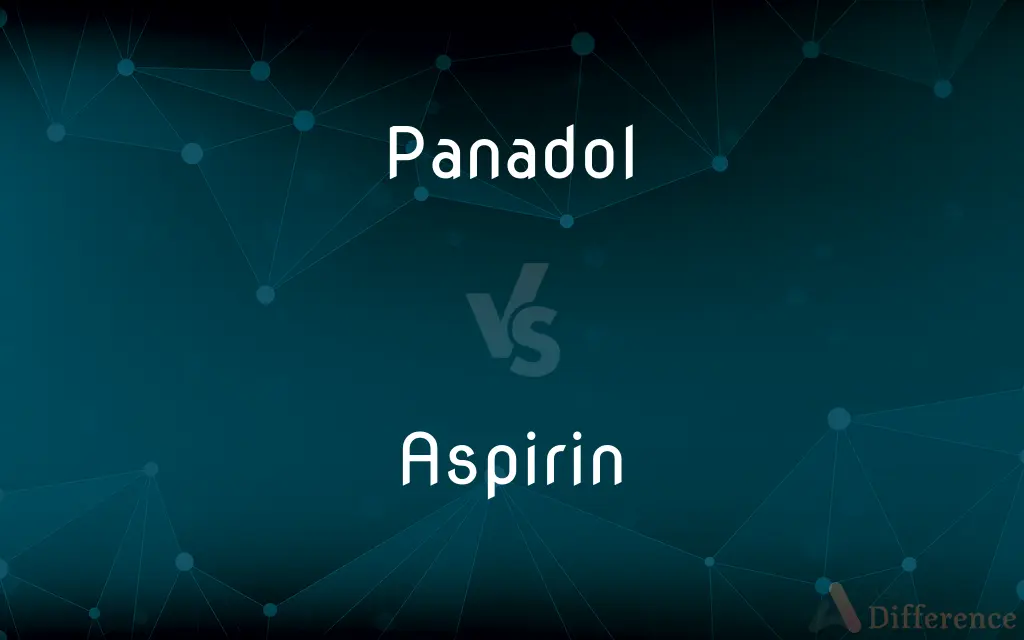Panadol vs. Aspirin — What's the Difference?
Edited by Tayyaba Rehman — By Maham Liaqat — Updated on March 20, 2024
Panadol, containing paracetamol, is primarily used for pain relief and reducing fever; Aspirin, with acetylsalicylic acid, also relieves pain but has anti-inflammatory properties and blood-thinning effects.

Difference Between Panadol and Aspirin
Table of Contents
ADVERTISEMENT
Key Differences
Panadol, which contains the active ingredient paracetamol, is widely used for its analgesic (pain-relieving) and antipyretic (fever-reducing) properties. It works by blocking chemical messengers in the brain that signal pain and fever. Aspirin, on the other hand, contains acetylsalicylic acid and not only relieves pain and reduces fever but also offers anti-inflammatory benefits, making it effective for treating inflammation-related conditions. Additionally, aspirin inhibits platelet aggregation, contributing to its role in preventing clots.
While Panadol is often recommended for individuals seeking relief from general pains like headaches, muscle aches, and fever without the risks associated with NSAIDs (non-steroidal anti-inflammatory drugs), Aspirin is utilized for its broader therapeutic effects, including its potential to reduce the risk of heart attack and stroke in certain individuals. This difference in action makes aspirin particularly valuable in cardiovascular disease management, whereas Panadol is more suited for routine pain and fever management.
Panadol's safety profile allows it to be used by a wide range of individuals, including pregnant women and those with gastrointestinal sensitivities, as it is less likely to cause stomach ulcers or bleeding compared to NSAIDs like aspirin. However, excessive intake of Panadol can lead to liver damage, emphasizing the importance of adhering to recommended dosages. Aspirin, while beneficial for its anti-inflammatory and antithrombotic properties, is associated with an increased risk of gastrointestinal bleeding and should be used cautiously, especially in higher doses or long-term therapy.
The choice between Panadol and Aspirin for pain management and other health concerns often depends on the individual's specific health profile, including their risk factors for heart disease, their tolerance for certain medications, and the primary health issue being addressed. For example, someone with arthritis might prefer aspirin for its anti-inflammatory effects, while someone with a simple headache and no underlying conditions might opt for Panadol for pain relief.
Both Panadol and aspirin are available over the counter and are widely used around the world. However, their differences in mechanism of action, potential side effects, and applications in medical treatment highlight the importance of choosing the right medication based on the individual's health needs and under the guidance of a healthcare professional.
ADVERTISEMENT
Comparison Chart
Active Ingredient
Paracetamol
Acetylsalicylic Acid
Mechanism of Action
Blocks pain signals in the brain
Inhibits enzymes and reduces inflammation, prevents blood clots
Recommended For
Headaches, Muscle aches, Fever
Inflammatory conditions, Heart attack and stroke prevention
Side Effects
Less likely to cause stomach issues, potential liver damage with overdose
Gastrointestinal bleeding, Increased bruising, not recommended for children with viral infections
Special Considerations
Safe for most populations, including pregnant women
Should be used with caution in individuals with gastrointestinal issues or bleeding disorders
Compare with Definitions
Panadol
Known for its safety and less gastrointestinal side effects.
Doctors recommend Panadol for patients with sensitive stomachs.
Aspirin
Not recommended for children with viral infections due to the risk of Reye's syndrome.
Avoid giving aspirin to children with the flu.
Panadol
Should be used within the recommended dosage to avoid liver damage.
Always check the Panadol dosage to prevent overdose.
Aspirin
Used to treat conditions from headaches to reducing the risk of heart attacks.
He uses aspirin to manage his arthritis pain.
Panadol
A pain relief medication containing paracetamol.
She took Panadol to relieve her tension headache.
Aspirin
Can cause gastrointestinal side effects and should be used cautiously.
Aspirin can lead to stomach ulcers if taken excessively.
Panadol
Used for reducing fever and relieving mild to moderate pain.
Panadol is often given to children to reduce fever.
Aspirin
Has anti-inflammatory and antipyretic effects in addition to pain relief.
Aspirin can reduce fever and inflammation effectively.
Panadol
Available over the counter for convenient access.
You can buy Panadol at any pharmacy without a prescription.
Aspirin
Aspirin, also known as acetylsalicylic acid (ASA), is a medication used to reduce pain, fever, or inflammation. Specific inflammatory conditions which aspirin is used to treat include Kawasaki disease, pericarditis, and rheumatic fever.Aspirin given shortly after a heart attack decreases the risk of death.
Panadol
(pharmaceutical drug) paracetamol; acetaminophen.
Aspirin
A white, crystalline compound, C9H8O4, derived from salicylic acid and commonly used in tablet form to relieve pain and reduce fever and inflammation. It is also used as an antiplatelet agent. Also called acetylsalicylic acid.
Panadol
An analgesic for mild pain; also used as an antipyretic; (Datril and Tylenol and Panadol and Phenaphen and Tempra and Anacin III are trademarks of brands of acetaminophen tablets)
Aspirin
A tablet of aspirin.
Aspirin
An analgesic drug, acetylsalicylic acid
Aspirin
(countable) a tablet containing this substance
Aspirin
A white crystalline compound, acetyl salicylic acid (CH3.CO.O.C6H4.CO.OH) widely used as a drug for relief of pain and alleviation of fever. It has analgesic, antipyretic, and antiinflammatory properties, and is one of a class of agents called non-steroidal antiinflammatory drugs (NSAIDs). The name was originally a trade name, but has become the preferred name for the substance. It is actually a prodrug, liberating salicylic acid, the ultimate pharmacologically active agent, in the intestines. It is more effective when taken orally than is salicylic acid, because it dissolves more readily.
Common Curiosities
What is Panadol used for?
Panadol is primarily used for relieving pain and reducing fever.
What should I do if I overdose on Panadol?
Seek medical attention immediately if you suspect a Panadol overdose.
Can I take Panadol for a headache?
Yes, Panadol is effective for relieving headaches.
Can I take Aspirin for inflammation?
Yes, Aspirin has anti-inflammatory properties and can be used to treat inflammatory conditions.
Does Panadol affect the stomach?
Panadol is less likely to cause gastrointestinal side effects compared to NSAIDs like Aspirin.
Is Aspirin safe for everyone?
Aspirin should be used with caution, especially in individuals with gastrointestinal issues or those at risk of bleeding.
Does Panadol have any serious side effects?
While generally safe, excessive intake of Panadol can lead to liver damage.
Is Panadol suitable for children?
Yes, Panadol is considered safe for children, but always follow the dosage guidelines.
How often can I take Aspirin for pain?
Follow the recommended dosage on the label or consult a healthcare professional for guidance.
Are there alternatives to Panadol and Aspirin?
Yes, there are other pain relievers and fever reducers available, but choose one based on your specific health needs and consult with a healthcare professional.
Is Panadol an NSAID?
No, Panadol (paracetamol) is not classified as an NSAID.
Can I take Aspirin if I'm pregnant?
Aspirin should only be taken during pregnancy under the guidance of a healthcare provider.
Can Aspirin be used for fever?
Yes, Aspirin can reduce fever in addition to its other uses.
Share Your Discovery

Previous Comparison
Terminology vs. Jargon
Next Comparison
Foundation vs. CreationAuthor Spotlight
Written by
Maham LiaqatEdited by
Tayyaba RehmanTayyaba Rehman is a distinguished writer, currently serving as a primary contributor to askdifference.com. As a researcher in semantics and etymology, Tayyaba's passion for the complexity of languages and their distinctions has found a perfect home on the platform. Tayyaba delves into the intricacies of language, distinguishing between commonly confused words and phrases, thereby providing clarity for readers worldwide.
















































